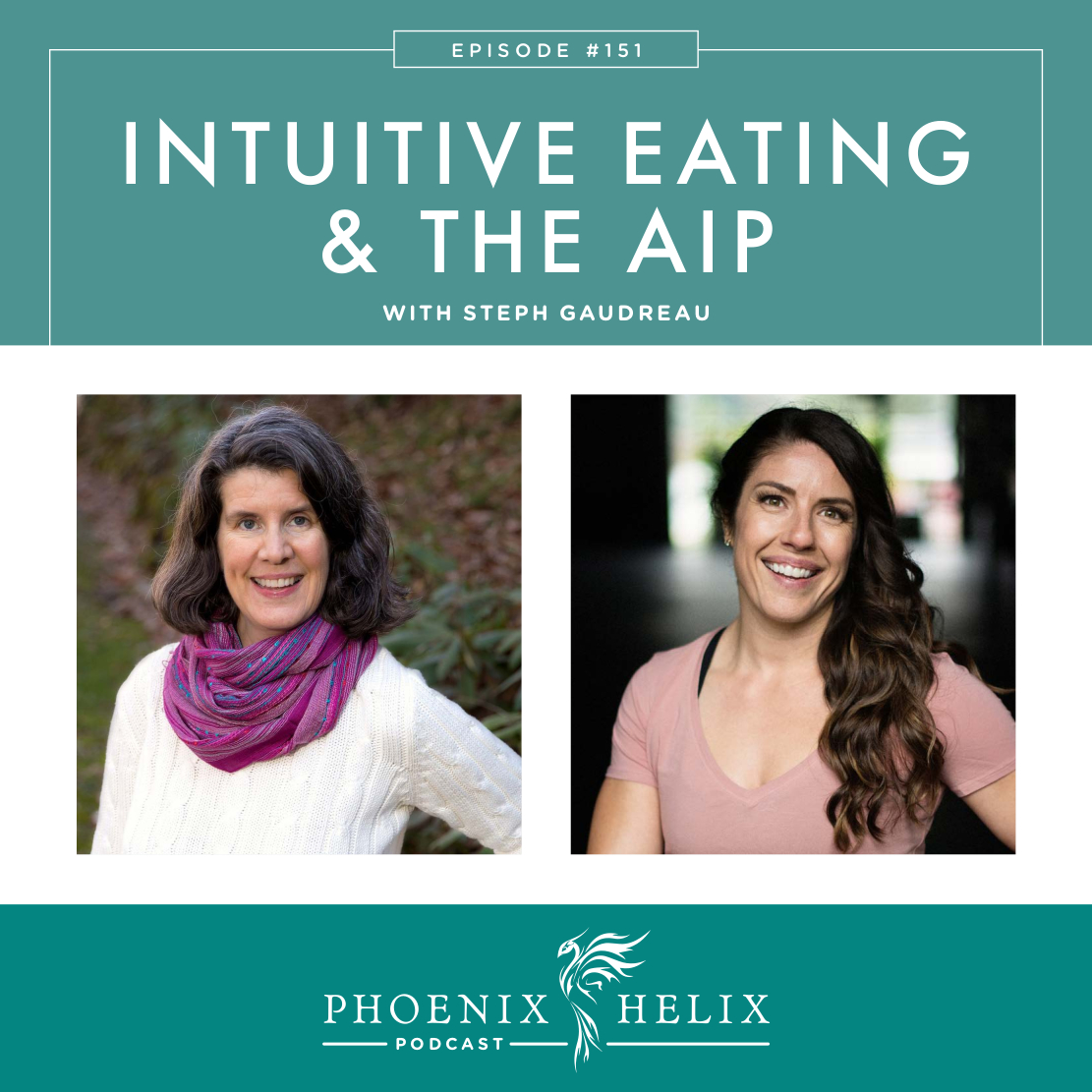
Are These Conflicting Dietary Philosophies?
Many people think of the AIP as a list of foods you can and can’t eat, but the elimination phase isn’t meant to last forever. Reintroductions are an important part of the process. And even within the elimination phase, the more variety and joy we take in our diet, the healthier it becomes.
When you hear the words Intuitive Eating, you might think, “My intuition tells me to eat junk food! I can’t listen to that.” But intuition and cravings are not the same thing. Intuitive Eating is a deep multi-layered philosophy, and nutrition is one of those layers.
Today, we’re going to be talking about how these protocols can be blended for autoimmune health. My guest is Steph Gaudreau, author, certified intuitive eating counselor, and nutritional therapy practitioner.
Listen to the Show
- Subscribe to my podcast through your favorite podcast app: iTunes, Stitcher, Google, TuneIn, Spotify, Amazon, etc.
- You can also listen to the episode right here through the player below, and if you subscribe to my newsletter you’ll get notified of future episodes.
Podcast: Play in new window | Download
Show Notes
- Intro (0:00)
- Thank You to Our Podcast Sponsor: ShopAIP (3:10)
- I collaborated with ShopAIP to create a Phoenix Helix Bundle, which contains some of my favorite AIP pantry items. It’s a great way to sample their products!
- ShopAIP is an online store dedicated to the Paleo Autoimmune Protocol. With hundreds of items for the elimination phase of the AIP, and new products labeled by reintroduction category as well. You can find protein bars, sauces and condiments, AIP-friendly spices, cooking and baking ingredients, delicious snacks, non-toxic skincare, and more.
- If you’re a first-time customer, use the code PHOENIX for 10% off your order. Purchase here.
- Meet Steph (4:20)
- Steph Gaudreau is a certified intuitive eating counselor, nutritional therapy practitioner, and strength coach. She’s also the author of The Core 4, and the host of the Listen To Your Body Podcast. She has autoimmune disease herself: endometriosis.
- She’s been part of the paleo community since 2010 but has evolved in her personal and professional approach to health. She was first drawn to paleo for weight loss benefits, and her website at that time was called Stupid Easy Paleo. But after spending many years in the paleo community, she saw people struggling with trusting themselves around food. Food fear was common. People felt conflicted about what foods they should and shouldn’t eat, and would beat themselves up if they ate anything from the “unhealthy” list. She was experiencing these feelings, too.
- She started learning about intuitive eating and after experiencing the benefits personally, decided to make it the focus of her career. Her goal is to help people approach food with less fear, learning to honor their body/mind/spirit and their health principles at the same time.
- Healing Diets & Listening to Your Body (10:27)
- Protocols like the paleo autoimmune protocol are great starting points, especially when you’re experiencing poor health. They provide clear guidelines to start feeling better. But they are meant to be a template. At some point, you need to personalize your diet for your body and your lifestyle. That’s why reintroductions are an important part of the AIP. That process is designed to help you listen to your body. Intuitive eating values listening to your body as well.
- What Is Intuitive Eating? (10:49)
- It’s a self-care framework that includes instinct, emotion, and rational thought.
- Instinct encompasses the body’s cues, and for many of us, we don’t trust our body’s cues. Intuitive eating teaches interceptive awareness – a deep and nuanced way to listen to your body on many levels.
- Emotion honors the mind-body connection. Food is more than calories. It inspires emotions, and emotions also impact our food choices and food experiences.
- Rational thought is part of the framework, too. One of the most common myths about intuitive eating is the belief that logic plays no role.
- It’s a framework – not a set of rules. While there are 10 principles, there’s no prescribed order for practicing them. It’s meant to be personal journey for each individual, and it’s also meant to be a lifetime practice. It’s not about success or failure.
- Resource: Intuitive Eating by Evelyn Tribole and Elyse Resch.
- Dieting for Weight Loss vs. Health (13:15)
- While originally intended to help people who diet for weight loss, the framework was created 25 years ago, before orthorexia was a known phenomenon. Even when the dietary goal is health, it’s possible to develop unhealthy behaviors around food.
- With the AIP, when you begin to connect certain foods to your autoimmune symptoms, it’s common to develop some food fears. Part of the healing journey is becoming empowered about our food choices, rather than fearful.
- Intuitive eating is designed to help people re-establish a healthy relationship with food, whatever the inspiration for their diet.
- 10 Principles of Intuitive Eating (17:22)
- 1. Reject the Diet Mentality
- 2. Honor Your Hunger
- 3. Make Peace with Food
- 4. Challenge the Food Police
- 5. Feel Your Fullness
- 6. Discover the Satisfaction Factor
- 7. Honor Your Feelings Without Using Food
- 8. Respect Your Body
- 9. Movement—Feel the Difference
- 10. Honor Your Health with Gentle Nutrition
- Does Principle #1 Mean That Intuitive Eating is Anti-AIP? (18:05)
- The language of the intuitive eating framework is focused on weight loss. Research shows that dieting for weight loss isn’t effective. The majority of people regain the weight in 2-5 years, and the end result is poorer health. Intuitive eating is an alternative to weight loss diets.
- However, healing diets like the AIP are different – they’re a protocol rather than a pattern of behavior. You can incorporate intuitive eating principles into a healing diet.
- A foundation of intuitive eating is developing self-awareness around food. Restrictive eating – even when the goal is autoimmune health – can have emotional and psychological effects. Questions to ask yourself: What are the reasons behind your food restrictions? In addition to your health goals, do you also have weight loss goals associated with this diet? Are you limiting your calories? Have you done the AIP as intended, including reintroductions, or are you afraid to do reintroductions? When you eliminate a food from you diet, do you experience a backlash effect where all you want to do is eat that food? Does restriction trigger bingeing (loss-of-control eating)? Is your healing diet taking an emotional or psychological toll?
- Resource podcasts:
- Thank You to Our Podcast Sponsor – Paleo on the Go (24:00)
- A frozen meal delivery service, 100% of their menu is compliant with the elimination phase of the paleo autoimmune protocol (AIP). They have over 5o items, including entrees, side dishes, broth, AIP-friendly bacon, and desserts.
- Use the code PHOENIX for 10% off your first order.
- Principle #4: Challenge the Food Police (26:38)
- When we think of the “food police” we often think of people online who criticize our food choices. They’re often called “paleo police” or “AIP police” in our community.
- However, in the intuitive eating framework, our inner voices are the most important. There’s a difference between destructive dieting voices and ally voices that support our health.
- Destructive dieting inner voices develop over a lifetime and can come from many different places – doctors, parents, peers, culture, society, our past experiences with dieting, etc. They’re judgmental, critical, and inspire guilt and shame. Red flags: attaching any of the following words to your food choices: should/shouldn’t, good/bad, clean/dirty, healthy/unhealthy. Sometimes people object to this idea, saying that some foods are healthier than others. While it’s true that different foods have different nutrition profiles and may have different impacts on your body, moralizing about food is more harmful than helpful.
- Honoring the body with gentle nutrition is part of the intuitive eating framework, but it’s an objective rather than judgmental approach. An example of a powerful ally inner voice is a “food anthropologist.” This voice is an objective observer, noting your food choices, the circumstances surrounding them, and how those foods made you feel. There is no criticism in this voice, and no catastrophic predicting of outcomes. It’s simply gathering information for self-knowledge. It inspires learning rather than shame.
- Examples of the difference between these two voices: Maybe you eat a food that you know or fear will cause your body to flare. A destructive inner voice would say: “Why did you do that? You’re so stupid. You’re going to pay for this. You’re going to be in so much pain tomorrow, and you deserve it. You know better.” In contrast, a powerful ally voice would say: “Okay, what were the circumstances surrounding this choice? Were you hungry, and it was the only food available? Did you feel pressured by family or friends to eat that food? Were you stressed and chose this food for comfort? How would you like to approach a similar situation in the future? You might flare, but you might not. Emotions can cause flares just as much as food can, so let’s stay calm and neutral and simply observe what happens.”
- Intuitive eating incorporates self-knowledge, self-care, and self-compassion. Become aware of your own inner voices. Explore where they came from. Work to replace destructive dieting voices with healthful ally voices instead.
- Principle #6: Discover Your Satisfaction Factor (42:07)
- Food is meant to be enjoyed, and when we follow diets – whether for healing or weight loss – we sometimes forget this fact. Especially when our old favorite foods aren’t part of our new dietary template. A key tenet of intuitive eating is rediscovering the pleasure in food again.
- Simple meals can be delicious. You don’t have to be a master chef to enjoy your food. A classic chef formula is salt, fat, acid, heat – four simple things that bring flavor to food. Texture makes a difference, too. Sometimes adding a crunchy ingredient or topping takes it to another level.
- If you miss a food that now causes you to flare, ask yourself what specifically you loved about that food? For example, if your family made pizza together and you loved having fun in the kitchen as a family, can you do that with an AIP pizza recipe, or a different type of meal altogether?
- It’s good to try new foods because our tastes do change over time, but if you’ve tried a particular food a number of ways and just don’t like it, it’s fine not to eat it, even if it’s supposed to be good for you.
- The atmosphere and setting are part of enjoying food as well. Sitting at a table with friends feels different than eating on the run. Eating at a cluttered table feels very different than one that’s clear. Conversation matters – do you have enjoyable conversations with your family at dinnertime, or is that when everyone airs their grievances? How about playing some music in the background? Would that make your meal more pleasant? There are lots of entry points to increase pleasure in eating.
- Intuitive Eating Resources (49:54)
- Intuitive Eating by Evelyn Tribole and Elyse Resch. Their newest revised edition just released this week. They also have a workbook and a website.
- The Food Psych Podcast by Christy Harrison.
- Outro (50:51)
- Steph Gaudreau is a certified intuitive eating counselor, nutritional therapy practitioner, and strength coach. She offers coaching on intuitive eating, and you can connect with her through her website. She’s also the author of The Core 4, and the host of the Listen To Your Body Podcast.
- Eileen (your podcast host) is the author of multiple books, written to help people thrive with autoimmune disease. Learn more on the Books Page.
- If you like this podcast, follow or subscribe through your favorite podcast app. You can also subscribe to Eileen’s biweekly newsletter.
- Check out the entire archive of podcast episodes.
You May Also Be Interested In
Spreading the Word
If you like the podcast, please leave a positive review in iTunes. It would mean the world to me, and also helps others find the podcast. Here are some quick instructions using your iPhone:
- If you are already subscribed to my podcast: (1) Click the purple podcast icon. (2) At the bottom of the screen, click Library. (3) At the top of the screen, click Shows. (4) Click the Phoenix Helix podcast image. (5) Scroll down the page, and you’ll see Ratings and Reviews. Scroll down a little bit more and click on Write a Review. This will bring up the review screen. Tap 5 stars (if you love the podcast), and then click in the title box, and it will bring up the keyboard. Enter a title and short review. (6) Click Send in the upper right corner. (7) Thank you! Positive reviews give the podcast a higher search ranking in iTunes, helping people find it and letting them know it’s a quality podcast and worth their time to listen.
- If you haven’t subscribed to my podcast: (1) Click the purple podcast icon. (2) In the lower right corner, click the magnifying class. (3) Type Phoenix Helix in the search box. (4) Click the podcast cover in the Show list. (5) If you’d like to subscribe, click the + sign at the top of the screen. (6) To write a review, scroll down the page, and you’ll see Ratings and Reviews. Scroll down a little bit more and click on Write a Review. This will bring up the review screen. Tap 5 stars (if you love the podcast), and then click in the title box, and it will bring up the keyboard. Enter a title and short review. (7) Click Send in the upper right corner. (8) Thank you! Positive reviews give the podcast a higher search ranking in iTunes, helping people find it and letting them know it’s a quality podcast and worth their time to listen.







